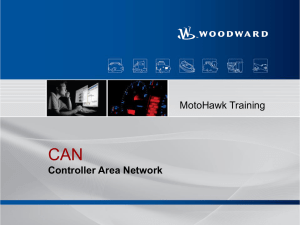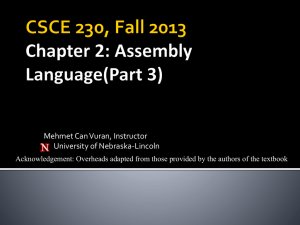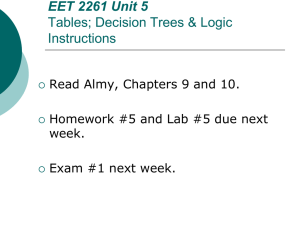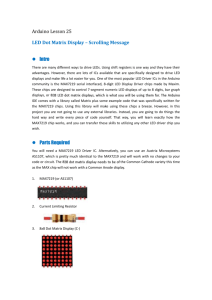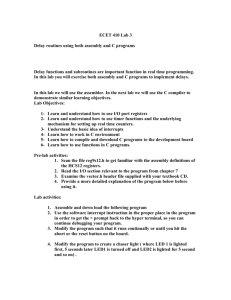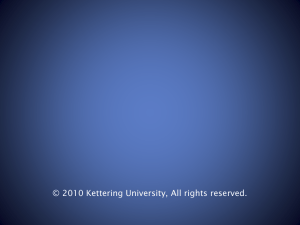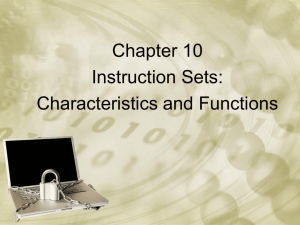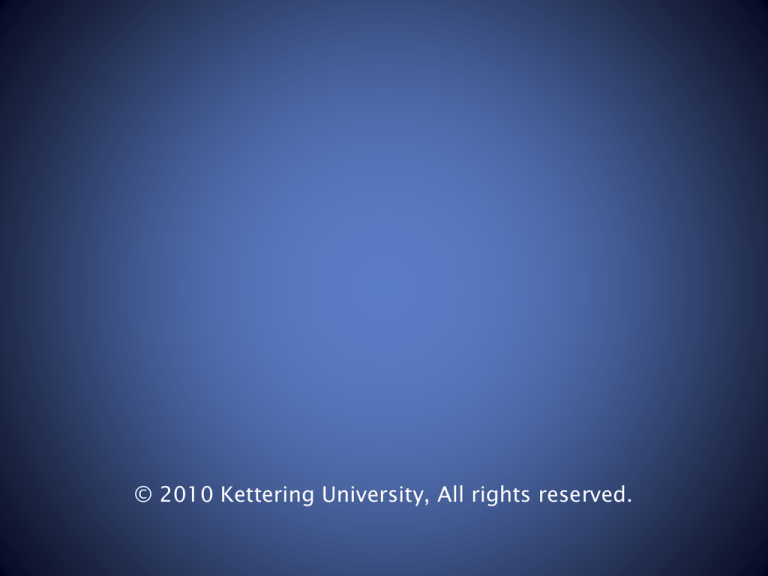
© 2010 Kettering University, All rights reserved.
Microcomputers I – CE 320
Jaerock Kwon, Ph.D.
Electrical and Computer Engineering
Kettering University
jkwon@kettering.edu
http://www.kettering.edu/~jkwon
Announcements
• Quiz 3 on Monday
30 mins to fill out addresses and contents in a listing file.
Exercise 3 will be greatly helpful.
Lecture 12 :
Boolean Logic Instructions
Today’s Goals
• Learn how to use Boolean instructions in assembly code
Logical Instructions
• One of the main purposes of the logical instructions is to
affect individual bits of a byte without affecting the others.
• Target and Mask byte
Target byte with the data
Mask byte which determines which bits are affected.
• Format
[logical instruction][register or memory] [mask byte]
Ex. ANDA #%00001111
Function
0 Mask Bit
1 Mask Bit
AND
Clear to 0
No affect
OR
No affect
Set to 1
XOR
No affect
Toggle
AND
ANDA and ANDB
• ANDA and ANDB
affect N and Z
clear V
no affect on C
• Example
Determine if the number in location $1000 is evenly
divisible by 8.
LDAA
$1000
ANDA
#%00000111 ; or #$07
; If the Branch is taken, the number is divisible
BEQ
xxx
OR, XOR, and NOT
• ORAA, ORAB
affect N and Z
clear V
no affect on C
• EORA, EORB
(meaning XOR)
affect N and Z
clear V
no affect on C
• COMA, COMB, COM
(meaning NOT)
All eight bits are complemented.
A mask byte is not used. (right?)
affect N, Z
clear V
set C to 1
Example
• Consider a two-door sports car with a trunk and a glove box.
Assume that contact switches are used to
• monitor each door and
• send signals to the processor indicating
whether the door is open (TRUE) or closed (FALSE)
• Four bits are need to monitor two side doors, a trunk, and a glove
box.
• The four bits will be 7, 6, 5, and 4 of memory $0000.
Microprocessor can read the contents of this location at any time
to read the status of the doors.
Also the microprocessor maintains a bit for the cabin light, the
trunk light, and the glove box light.
• Storing a 0 in the bit causes the light to be OFF
• Storing a 1 makes the light ON.
• These three bits will be 2, 1, and 0 of the location $1000 respectively
$0000
7
6
GBOXD LEFTD
5
4
RGHTD TRNKD
3
-
2
GBOXL
1
CBNL
0
TRNKL
Example
Turn off the glove box light without affecting the other bits.
• Turn OFF Use AND with a proper mask byte
LDAA
ANDA
STAA
$00
#%11111011
$00
7
6
$0000 GBOXD LEFTD
5
4
RGHTD TRNKD
3
-
2
1
GBOXL CBNL
0
TRNKL
Example
Turn on the trunk light without affecting the other bits.
• Turn ON Use OR with a proper mask byte
LDAA
ORA
STAA
$00
#%00000001
$00
7
6
$0000 GBOXD LEFTD
5
4
RGHTD TRNKD
3
-
2
1
GBOXL CBNL
0
TRNKL
Example
Turn on the glove box light and the cabin light without affecting the other bits.
• Turn ON Use OR with a proper mask byte
LDAA
ORA
STAA
$00
#%00000101
$00
7
6
$0000 GBOXD LEFTD
5
4
RGHTD TRNKD
3
-
2
1
GBOXL CBNL
0
TRNKL
Example
Toggle the cabin light without affecting the other bits.
• Toggle Use XOR with a proper mask byte
LDAA
EORA
STAA
$00
#%00000010
$00
7
6
$0000 GBOXD LEFTD
5
4
RGHTD TRNKD
3
-
2
1
GBOXL CBNL
0
TRNKL
Example
Negate accumulator D
• Negate accumulator D
COMA
COMB
ADD
#1
• Negate D without using the logical complement functions
EORA
EORB
ADDD
#%11111111
#%11111111
#1
; #$FF
; #$FF
Example
Toggle the cabin lights at exactly 1000 Hz
flip:
loop:
LDAA
EORA
STAA
LDX
DEX
BNE
BRA
$00
#CBNL
$00
#N
loop
flip
;
;
;
;
;
;
;
3
2
3
2
N
3(N-1)+1
3
•
1KHz 1000 times / sec
•
Clock speed of Dragon12+:
24 MHz (24,000,000 Hz) means 24 million clock cycles / sec
•
When the sum of all cycles of the lines become 24,000, we can say the
module runs 1,000 times per second.
•
3 + 2 + 3 + 2 + N + 3(N-1) + 1 +3 = 24,000
11 + 4N = 24,000 then, 4N = 23989. Therefore, N = 5997.25
N should be an integer, so 4N + 11 + ? = 24,000
If 5 is used for ?, then N = 5996
Example - continued
Toggle the cabin lights at exactly 1,000 Hz
flip:
loop:
LDAA
EORA
NOP
NOP
BRA
STAA
LDX
DEX
BNE
BRA
$00
#CBNL
0
$00
#5996
loop
flip
;
;
;
;
;
;
;
;
;
;
3
2
1
1 (to add 5 extra clock cycles)
3 (use 3 clock cycles while do nothing)
3
2
5996
3(5996-1)+1
3
A Short Story about K and M in bytes
• In general,
K means 1,000
M means 1,000,000
• When you count bytes,
K means 1,024
M means 1,024 x 1,024
• 1,024 comes from
210 = 1,024
Remember 2, 4, 8, 16, 32, 64, 128, 256, 512, 1024, …
Questions?
Wrap-up
What we’ve learned
• Boolean logical instructions
• ANDx, ORAx, EORx, and COMx
What to Come
• Bit instructions
• Stack
• Subroutines


